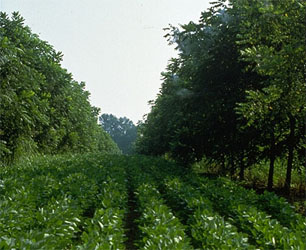What is it?
Alley cropping is the cultivation of food, forage or specialty crops between rows of trees. It is a larger version of intercropping or companion planting conducted over a longer time scale. Alley cropping can provide profitable opportunities for row crop farmers, hardwood timber growers, nut growers and Christmas tree growers.
Benefits: Alley cropping benefits both humans and the environment
-
Income diversification. Crop production during the years before nut trees come into bearing or hardwood timber is harvested creates cash flow and diversifies farm income, thereby improving the return on long-term investments in trees.
-
Marginal land improvement. By planting rows of nut or timber trees on land where annual crop production is low due to erosion or other limitations, marginal croplands may be converted to higher value woodlands.
-
Shelter. Rows of trees reduce wind speed, thereby controlling wind erosion. They also create sheltered microclimates that improves the yield and quality of crops growing in the alleys.
-
Wildlife. Alley cropping increases the biodiversity of cropland which creates new habitat for wildlife.
Alley cropping enterprises:
-
Hardwood timber or nut trees: Hardwoods such as black walnut or pecan may be combined with annual crops such as corn or soybeans.
-
Forage crops can be cultivated between tree rows for harvest or livestock grazing, or shrubs palatable to livestock can be grown for fodder, e.g. tagasaste.
-
Possible alley crops also include specialty crops, e.g. herbal or medicinal, perennials such as conifers for Christmas trees, and even nursery stock, e.g. using the Pot-in-Pot system.
-
Combine specialty crops with conventional field crops: Another alternative is to plant rows of perennial specialty crops within a field of tall field crops such as corn to diversify income while maintaining annual crop production.


